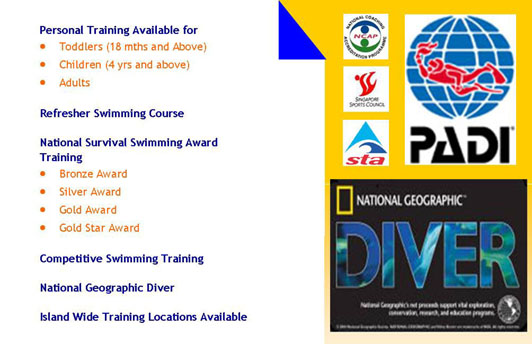





COURSES & FEES

Registration via SMS to :
977 22 563
1. <Names of Participants & Age>
2. <Select Class Type : Private / Semi-Private / Small Group / Big Group Classes>
3. <Prefer Training Day, Time & Venue>
4. <Prefer Male/Female Coach or No Preference>
5. <Commencement Date>
6. <Home Telephone & Mobile Numbers>
7. <Remarks>
8. <Your Name>
Example : Apple 5 and Amy 6. Semi-Private Class, Sunday 5.30pm, Katong Swimming Complex. Female Coach. 6 March 2006. Tel : 6338-8888 / 9111-8888. We want a patience female coach who is good at coaching young kids. From Ms Tang.

> Introduction to Swimming
Teaching Students Breathing Drills. Breathing is the foundation of life and swimming! From the start, they must be taught progressive, systematic breathing. The beginner is first taught to breathe as a dryland exercise (naturally), then using a ping pong ball in the water, and then with their faces in the water.
> Babies / Infants ( 6 months / 2 year olds )
The best time for introducing babies to swimming environment is 2 to 6 month from birth. The benefits of infant swimming stretch out in many different ways.
1) At an early age babies can learn swimming much more easily as it's more natural for them and they not scared of water.
2) On land, the movement of babies is restricted, as they cannot walk by themselves. So there is not enough exercise for the body. But in water the babies have a free movement, which stimulates better muscle development, and they grow up as healthier and happier babies.
3) Researches have proved that babies who start swimming at an early age are more active and receptive to their environment. Their brain development and problem solving skills are better.
In a nutshell, this course is a relationship-building programme. It builds and cultivates the relationship between you and your child, as well as the relationship your child has with the water.
Instructors work in the water, teaching adults/guardians how to hold an infant correctly and work with the reflexes that they already possess at this young age.
Being able to swim is one of life's true pleasures. Infant and preschool aquatics -- Babies can be taught the confidence to float, and the skill to kick up to the surface or swim back to the side unaided and thus a better chance of survival. Minimize chance of drowning. Floating is one of the most important skill because you have to be able to float if there is nothing to hold on to. As you practice more and more, baby will begin to relax and their confidence in the water will grow. This floating excercise begins to give baby the sense of their own buoyancy. It also gets them use to knowing when to breathe when they are bobbing up and down in the water. However not all babies manage to float on their own at first, it can be a very long process. If baby finds it hard, don't worry just keeps practicing.
WARNING! Irrespective of aquatic ability, no one should be considered water-safe. It is recommended that the baby / infant child has completed their course of injections.
> Toddlers ( 2 - 7 year olds )
Children learn basic rhythmic breathing, floating and strokes progressively. Once they are comfortable in the water, The Coach will introduce a program for children and adult. Course includes rhythmic breathing, floating & strokes. Participants are also introducing to Breaststroke, Front Crawl, Backstroke and Butterfly. Basic water safety & rescue skills will also be taught.
National Survival Swimming Skill Award
A program for student who have completed the learn to swim program than they will further their skill in survival. The Coach will introduce the next stage - National Survival Swimming Awards ( Singapore Sports Council ).
> Adults
Beginners will learn basic rhythmic breathing, floating and strokes progressively. Once they are comfortable in the water, The Coach will introduce a program for children and adult. Course includes rhythmic breathing, floating & strokes. Participants are also introducing to Breaststroke, Front Crawl, Backstroke and Butterfly. Basic water safety & rescue skills will also be taught.
National Survival Swimming Skill Award
A program for student who have completed the learn to swim program than they will further their skill in survival. The Coach will introduce the next stage - National Survival Swimming Awards ( Singapore Sports Council ).

> National Survival Swimming Award Certification
The course is adapted from the STA Survival Test (UK), introduced in Singapore in 1979. It is designed to educate and create awareness of basic water survival skills to ensure an individual's safety during an emergency.
The test simulates the sinking of a ship laden with passengers and goods. For eg, the speed swim tests your ability to escape 100 m from the whirlpool that a sinking ship usually creates. "Survivors" are also expected to make floats with their clothes in order to keep afloat while awaiting rescue.
All of the SSC's 28 swimming complexes offer the tests, with the exception of the Gold Star test, which is available only at Toa Payoh, Queenstown, Jurong Town and River Valley Swimming Complexes.
Many of the private swimming pools and clubs with standard 50 m or 25 m lap pools also participate in the NASSA scheme, and actively conduct training lessons and tests for each proficiency level of NASSA. Any SSC-licensed swimming instructor will be qualified to take you through the necessary preparation.
> Bronze Award
Testing Criteria :-
1. Effect an entry from the side of the pool by a straddle or tuck jump.
2. Swim 50m.
3. Demonstrate ability to ?drown-proof? for 1 minute.
4. Tread water with both arms for 3 minutes.
5. Undress in water and demonstrate ability make float with attire.
6. Swim 400m using any strokes.
7. During the course of this swim, the participant must execute 1 dive, legs first. (The dive must swim submerged for at least 5m)
8. Climb out from the deep end of the pool without the use of steps or assistance.
> Silver Award
Testing Criteria :-
1. Effect an entry from the side of the pool by a straddle or tuck jump.
2. Swim 100m within 4 minutes.
3. Demonstrate ability to ?drown-proof? for 1 minute.
4. Tread water for 1 minute with 1 arm, the other arm at back of body.
5. Immediately after, tread water with both arms for 3 minutes.
6. Undress in water, make float with attire and use it to swim 25m using legs only.
7. Re-inflate if necessary.
8. Swim 200m using backstroke, 200m using sidestroke, 400m using front stroke (breastroke/freestyle).
9. During the course of this swim (front stroke), the participant must execute 1 dive head first, and 1 dive legs first. (Each dive must swim submerged for at least 5m)
10. Climb out from the deep end of the pool without the use of steps or assistance.
> Gold Award
Testing Criteria :-
1. Demonstrate a compact jump.
2. Straddle or tuck jump into the deep end of the pool, and swim 100m within 3 minutes.
3. Demonstrate ability to ?drown-proof? for 1 minute.
4. Tread water with 1 hand waving and held up for for 1 minute. The raised hand may be changed no more than 5 times.
5. Immediately after, tread water with both arms for 5 minutes.
6. Undress in water, make float with attire and use it to swim 25m using legs only.
7. Deflate float in water and inflate again before swimming another 25m with the float using legs only.
8. Swim 300m using backstroke, 300m using sidestroke, 400m using front stroke (breastroke/freestyle), within 45 minutes.
9. During the course of this swim (front stroke), the participant must execute 2 dives head first, and 2 dives legs first. (Each dive must swim submerged for at least 5m)
10. Climb out from the deep end of the pool without the use of steps or assistance.
> Gold Star Award
Testing Criteria :-
1. Effect an entry from a 3m platform with life jacket on and swim to the side of the pool. Climb out and remove life jacket.
2. Straddle or tuck jump into the deep end of the pool, and swim 100m in any stroke within 2.5 minutes.
3. Put on a life jacket thrown in from the side of the pool and remain in ?HELP? position for 1 minute.
4. Swim with life jacket for 50m, then remove life jacket and attire in the water.
5. Swim 500m using backstroke, 500m using sidestroke, 500m using front stroke (breastroke/freestyle), within 45 minutes.
6. Climb out from the deep end of the pool without the use of steps or assistance.

> Competitive Swimming Training
* Introduction to common sports injuries in swimming
* Nutrition and sports performance
* Competition rules
* Learning the starts / turn / finishes
* Individual Medley
* Sports Psychology
* Nutrition before and after competition
Nutritional Session
The basics of proper eating.
What to eat prior to your meet.
What to eat following practice.
How to avoid eating disorders.
What is in many of the things you currently eat?
What does your body need to perform at its peak?
SMALL GROUP
2 Pax S$180 / Pax
3 Pax S$160 / Pax
4 Pax S$140 / Pax
5 Pax S$120 / Pax
6 Pax S$100 / Pax
LARGE GROUP
7-12 Pax S$80 / Pax
TERMS & CONDITIONS
TIME TABLE SCHEDULE
Copyright @ 1994 The Swim Coach All Rights Reserved
